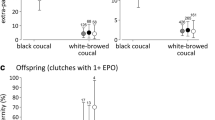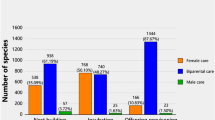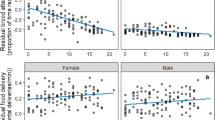Summary
Male investment in parental care has been hypothesized to be affected or not to be affected by their certainty of paternity, depending on the particular assumptions of theoretical models. We used data on paternal care and extra-pair paternity from 52 bird species to determine whether male parental care was related to certainity of paternity. Paternal care was measured as the relative male contribution to nest building, courtship feeding, incubation, and feeding of nestlings, respectively. Males of avian taxa did not provide less parental care during nest building, courtship feeding and incubation if the frequency of extra-pair paternity was high. However, male participation in feeding of offspring was significantly negatively related to the frequency of extra-pair paternity. This was also the case when the effects of potentially confounding variables such as developmental mode of offspring (which may result in males being freed from parental duties), extent of polygyny (which may result in less paternal care), and the frequency of multiple clutches during one breeding season (which may increase the probability of finding fertile females during the nestling period) were controlled statistically. These results suggest that the extent of paternal care has been affected by certainty of paternity, and that sex roles during the energetically most expensive parts of reproduction have been shaped by sperm competition.
Similar content being viewed by others
References
Becker WA (1984) Manual of quantitative genetics. Academic Enterprises, Pullman
Birkhead TR, Fletcher F (1992) Sperm to spare? Sperm allocation by male zebra finches. Anim Behav 43:1053–1055
Birkhead TR, Møller AP (1992) Sperm competition in birds: Evolutionary causes and consequences. Academic Press, London
Blümel H (1982) Die Rohrammer. A Ziemsen, Wittenberg-Lutherstadt
Clutton-Brock TH (1990) The evolution of parental care. Princeton University Press, Princeton
Cramp S (ed) (1985–1990) The birds of the Western Palearctic, vols 4–7. Oxford University Press, Oxford
Cramp S, Simmons KEL (eds) (1975–1983) The birds of the Western Palearctic, vols 1–3. Oxford University Press, Oxford
Davies NB (1992) Dunnock behaviour and social evolution. Oxford University Press, Oxford
Dyrcz A (1986) Factors affecting facultative polygyny and breeding results in the great reed warbler (Acrocephalus arundinaceus). J Ornithol 127:447–461
Feare C (1984) The starling. Oxford University Press, Oxford
Fisher J (1952) The fulmar. Collins, London
Frederick PC (1987) Responses of male white ibises to their mate's extra-pair copulations. Behav Ecol Sociobiol 21:223–228
Garland Jr T, Harvey PH, Ives AR (1992) Procedures for the analysis of comparative data using phylogenetically independent contrasts. Syst Zool 41:18–32
Gavin TA, Bollinger EK (1985) Multiple paternity in a territorial passerine: the bobolink. Auk 102:550–555
Gibbs HL, Weatherhead PJ, Boag PT, White BN, Tabak LM, Hoysak DJ (1990) Realized reproductive success of polygynous red-winged blackbirds revealed by DNA markers. Science 250:1394–1397
Goldstein H, Yom-Tov Y (1988) Breeding biology of the orange-tufted sunbird in Israel. Ardea 76:169–174
Gowaty PA, Bridges WC (1991) Behavioral, demographic, and environmental correlates of extrapair fertilizations in eastern bluebirds,Sialia sialis. Behav Ecol 2:339–350
Gowaty PA, Plissner JH, Williams TC (1989) Behavioural correlates of uncertain parentage: Mate guarding and nest guarding by eastern bluebirds,Sialia sialis. Anim Behav 38:272–284
Grafen A (1980) Opportunity cost, benefit and the degree of relatedness. Anim Behav 28: 967–968
Grafen A (1989) The phylogenetic regression. Phil Trans R Soc B 326:119–156
Gross MR, Shine R (1981) Parental care and mode of fertilization in ectothermic vertebrates. Evolution 35:775–793
Harrison C (1975) A field guide to the nests, eggs and nestlings of European birds with North Africa and the Middle East. Collins, London
Harrison C (1978) A field guide to the nests, eggs and nestlings of North American birds. Collins, Cleveland
Harvey PH, Pagel M (1991) The comparative method in evolutionary biology. Oxford University Press, Oxford
Hinde RA (1952) The behaviour of the great tit (Parus major) and some other related species. Behaviour Suppl 2
Kempenaers B, Verheyen GR, van den Broeck M, Burke T, van Broeckhoven C, Dhondt AA (1992) Extra-pair paternity results from female preference for high-quality males in the blue tit. Nature 357:494–496
Knowlton N, Greenwell SR (1984) Male sperm competition avoidance mechanisms: The influence of female interests. In: Smith RL (ed) Sperm competition and the evolution of animal mating systems. Academic Press, Orlando, pp 61–84
Lack D (1968) Ecological adaptations for breeding in birds. Chapman and Hall, London
Lack D, Lack E (1952) The breeding behaviour of the swift. Br Birds 45: 186–215
Low BS (1978) Environmental uncertainty and the parental strategies of marsupials and placentals. Am Nat 112:197–213
Lundberg A, Alatalo RV (1991) The pied flycatcher. Poyser, London
Marchant S, Higgins PJ (1990) Handbook of Australian, New Zealand & Antarctic birds, Vol I. Oxford University Press, Melbourne
Maynard Smith J (1977) Parental investment: A prospective analysis. Anim Behav 25:1–9
Møller AP (1986) Mating systems among European passerines: A review. Ibis 128: 234–250
Møller AP (1988) Paternity and paternal care in the swallowHirundo rustica. Anim Behav 36:996–1005
Møller AP (1994) Sexual selection and the barn swallow. Oxford University Press, Oxford
Møller AP, Birkhead TR (1992a) Validation of the heritability method to estimate extra-pair paternity in birds. Oikos 64:484–488
Møller AP, Birkhead TR (1992b) A pairwise comparative method as illustrated by copulation frequency in birds. Am Nat 139:644–656
Moreno J (1987) Parental care in the wheatearOenanthe oenanthe: Effects of nestling age and brood size. Ornis Scand 18:291–301
Morton ES (1987) Variation in mate guarding intensity by male purple martins. Behaviour 101: 211–224
Nice MM (1943) Studies in the life history of the song sparrow. Trans Linn Soc NY 6:1–328
Parker GA (1970) Sperm competition and its evolutionary consequences in the insects. Biol Rev 45:525–567
Parker GA (1984) Sperm competition and the evolution of animal mating strategies. In: Smith RL (ed) Sperm competition and the evolution of animal mating systems. Academic Press, Orlando, pp 1–60
Purvis A (1991) Comparative analysis by independent contrasts (C.A.I.C.): A statistical package for the Apple Macintosh, version 1.2. Department of Zoology, Oxford University, UK
Rabenold KN (1984) Cooperative enhancement of reproductive success in tropical wren societies. Ecology 65:871–885
Rowley I (1981) The communal way of life in the splendid fairy wren,Malurus splendens. Z Tierpsychol 55:228–267
Schönfeld M (1982) Der Fitislaubsänger. A Ziemsen, Wittenberg-Lutherstadt
Sibley CG, Ahlquist JE (1990) Phylogeny and classification of birds. Yale University Press, New Haven London
Siegel S, Castellan Jr NJ (1988) Nonparametric statistics for the behavioral sciences, 2nd edn. McGraw-Hill, New York
Stewart PA (1974) A nesting of black vultures. Auk 91:595–600
Summers-Smith D (1964) The house sparrow. Collins, London
Temrin H (1988) Polyterritorial behaviour and polygyny in the wood warbler (Phylloscopus sibilatrix). PhD thesis, University of Stockholm, Stockholm
Trivers RL (1972) Parental investment and sexual selection. In: Campbell B (ed) Sexual selection and the descent of man, 1871–1971. Aldine, Chicago, pp 136–179
Wagner RH (1992) Confidence of paternity and parental effort in razorbills. Auk 109: 556–562
Walsberg GE (1983) Avian ecological energetics. In: Farner DS, King JR, Parkes KC (eds) Avian biology, vol 7. Academic Press, New York, pp 161–220
Werren JH, Gross MR, Shine R (1980) Paternity and the evolution of male parental care. J Theor Biol 82:619–631
Westneat DF (1988) Male parental care and extra-pair copulations in the indigo bunting. Auk 105:149–160
Westneat DF, Sherman PW, Morton ML (1990) The ecology and evolution of extra-pair copulations in birds. Curr Ornithol 7:331–369
Whittingham LA, Taylor PD, Robertson RJ (1992) Confidence of paternity and male parental care. Am Nat 139:1115–1125
Whittingham LA, Dunn PO, Robertson RJ (1993) Confidence of paternity and male parental care: An experimental study in tree swallows. Anim Behav 46:139–147
Williams GC (1975) Sex and evolution. Princeton University Press, Princeton
Windt W, Ehrhardt J, Brün J (1991) Investieren Kohlmeisen-Männchen bei unsicherer Vaterschaft weniger in ihre Brut? Verh Dtsch Zool Ges 83:661
Winkler DW (1987) A general model of parental care. Am Nat 130:526–543
Wright J (1992) Certainty of paternity and parental care. Anim Behav 44:380–381
Xia X (1992) Uncertainty of paternity can select against paternal care. Am Nat 139: 1126–1129
Author information
Authors and Affiliations
Rights and permissions
About this article
Cite this article
Møller, A.P., Birkhead, T.R. Certainty of paternity covaries with paternal care in birds. Behav Ecol Sociobiol 33, 261–268 (1993). https://doi.org/10.1007/BF02027123
Received:
Accepted:
Issue Date:
DOI: https://doi.org/10.1007/BF02027123




